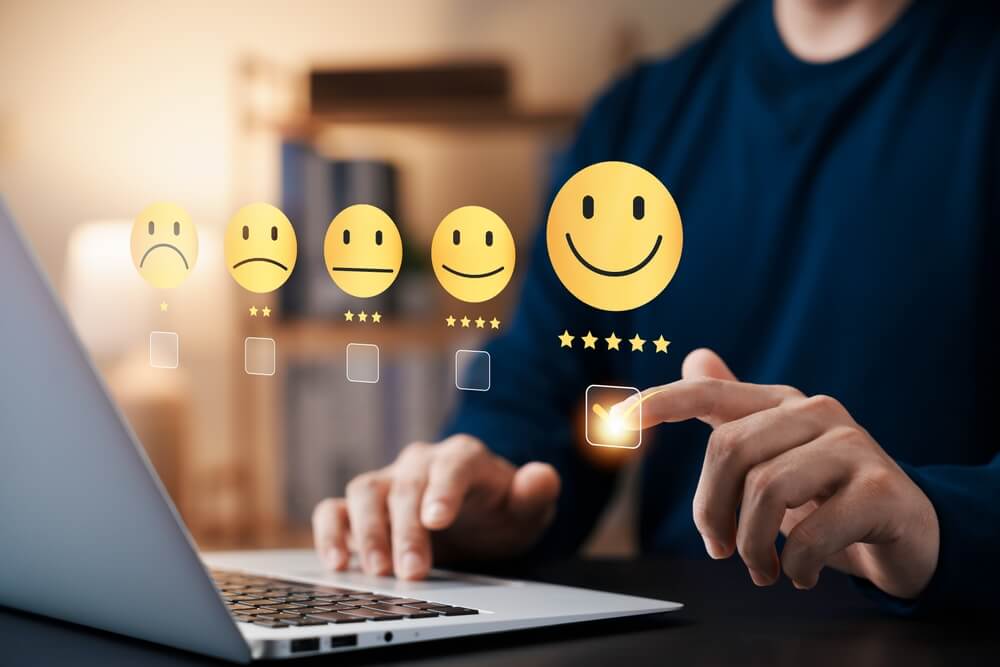Customer service and customer experience are often confused with each other. But they’re two separate concepts that can have a significant impact on how customers perceive your small business.
Here, we uncover how each contributes to brand awareness and customer loyalty, and why mastering them is crucial for long-term success.
Defining customer service and customer experience.
Customer service is your frontline; it’s the direct support and advice you offer for your products or services. This includes:
- Addressing customer queries,
- Resolving technical difficulties,
- Guiding product usage, and
- Handling complaints.
Customer experience (also known as CX) is a customer’s journey with your business. Every interaction between the customer and your business shapes their experience, including:
- Product/service quality,
- Pricing,
- Customer service encounters,
- Website usability,
- Brand aesthetic, and
- Responsiveness.
“Customer service is a science. Customer experience is an art. You can’t have one without the other, but to thrive as a modern business, you need to nail both.”
AnswerConnect Head of Customer Success Robert Phillips

The evolution of customer service.
In the past, customer service was transactional exchanges that ended when the sale was complete. If there were issues post-purchase, customers would’ve physically visited stores to express their concerns or ask questions.
Call centers later emerged as centralized hubs for customer interactions, with trained agents handling inquiries. These call centers allowed customers to seek assistance remotely. However, there was still limited accessibility after-hours and a lack of personalization that customers craved.
The internet and how it transformed customer service.
The customer service vs customer experience debate became even more exaggerated through the introduction of technology. The internet has transformed customer service from reactive problem-solving to proactive solutions. Traditional customer service methods like phone calls and in-person interactions are no longer enough to meet the quick pace and high demands of the modern consumer.
Instead, people want the freedom to find answers independently and in their own time, making self-service options the new norm.
Social media has also emerged as a powerful tool for customers to communicate with brands in real time. With 80% of 18-34-year-olds favoring brands that respond to questions or complaints via these platforms, small businesses must embrace social media as a form of customer service.

With the latest influx of artificial intelligence (AI) and automation tools in the online space, consumers expect customer service to be both instant and 24/7. Services such as chatbots and virtual receptionists allow small businesses with tight budgets and resource constraints to enhance their customer service with round-the-clock assistance.
The layers of customer experience.
While customer service is a crucial aspect of the overall customer experience, CX is the culmination of every touchpoint a customer has with your business, from browsing your website to post-purchase interactions.
To provide a positive customer experience, small businesses should consider:
Emotional engagement.
Creating emotional connections with customers is essential for a memorable experience. To do this, companies need to show they understand their customer’s goals, needs, and pain points.
For instance, when speaking to a potential customer about a product in your range, you could ask “What are you hoping to achieve with this purchase?” or “What would be the ideal scenario for you after purchasing this product?”
That way, you can identify how well the product will serve the customer’s needs, and potentially recommend a different product if their objective doesn’t align with the original product. This shows you’re looking to satisfy their requirements, but also that you’re not just trying to sell them any old product regardless of their goals.

Likewise, when speaking to a customer about their pain points, you can ask “Have you used anything similar in the past?” and “Did you encounter any issues with using that product? What were they?”
This shows you’ve anticipated their pain points and want to take steps to address them, rather than just giving them a one-size-fits-all service.
All of these small but meaningful moments help establish an emotional connection and show you care about the customer. And that’s crucial to establishing and enhancing brand loyalty.
Omnichannel consistency.
Customers interact with businesses through various channels; for example, they might start using a chatbot, move to a phone call with an agent, and end up on your website. Each communication platform should be seamless and consistent.
By investing in your omnichannel strategy, businesses can retain 89% of their customers compared with a 33% retention rate for companies with poor omnichannel strategy.

Customized interactions.
Customers now expect personalized experiences. Businesses can use data and insights to deliver these customized offerings, recommendations, and communications to enhance the value of the customer experience.
Points of convergence: Where customer service meets customer experience.
Customer service and CX, while distinct, are interconnected and work together to collectively shape and improve the customer journey. They are both responsible for:
- Customer satisfaction: Providing excellent customer service contributes to overall customer satisfaction. When customers receive prompt support, their satisfaction levels will increase.
- Brand perception: Customer service interactions shape the perception of the brand. Positive customer service experiences contribute to a favorable brand image.
- Customer loyalty: When customers have positive experiences and receive exceptional service, they are more likely to remain loyal to the brand and recommend it to others.

Impact on customer loyalty and retention.
The impact of customer service and CX on loyalty cannot be overstated. A staggering 96% of US consumers say customer service is important to their brand loyalty, while 76% say CX is a critical factor in their purchasing decisions.
When customers have consistently positive experiences with your small business, they’re more likely to become loyal advocates. They develop an emotional connection and trust in your company, leading the customer to make repeat purchases and recommend the company to others.
Loyal customers are also more likely to spend more money with your business. In fact, a company’s top 10% of most loyal customers will typically spend three times more per purchase than the other 90% of customers do.

To truly succeed as a small business, it’s essential you prioritize both aspects to retain customers and maintain your bottom line.
How to implement a holistic customer approach for your small business.
In any modern company, it should no longer be customer service vs customer experience. Instead, prioritize a holistic customer approach that involves integrating customer service and customer experience strategies. This involves:
- Understanding the customer journey: Identify key touchpoints and optimize interactions at each stage.
- Implementing feedback: Actively seek customer input and make data-driven decisions to enhance the overall experience.
- Creating a customer-first culture: Invest in staff training and ensure every employee understands the importance of delivering excellent customer service.
Meeting modern consumer expectations.
Consumers are becoming increasingly less patient or tolerant of poor customer service and CX. Whether it’s long waiting times, unresolved issues, or chatbot-led communications, poor customer service can harm people’s perception of your business. According to Zendesk, it only takes one bad experience for half of customers to switch to a competitor.
Small businesses must adapt their customer service and experience strategies to meet evolving expectations. You can do this by:
Embrace digital channels.
Customers expect businesses to be available across various digital channels, such as social media, live chat, and email. Being present and responsive on these channels is crucial for delivering exceptional service.

Offer customer self-service.
Most customers prefer self-service for simple issues, so empower your customers to find answers and solutions on their own through resources like knowledge bases, FAQs, and tutorials.
Provide proactive support.
More than two-thirds of customers want organizations to reach out with proactive customer notifications. By anticipating customer needs and addressing potential issues before they arise, customers know they matter to your business.
Innovate continuously.
Regularly gather and analyze customer feedback to identify areas for improvement. Use the data and insights to refine your processes and services to demonstrate your commitment to your customers’ wants.
Improve your customer journey today.
Small businesses that prioritize customer service and CX are more likely to succeed in building lasting relationships with their customers. It’s no longer customer service vs customer experience. By investing in both of these areas, your business can create a positive experience that starts before purchase and extends well beyond it.
We hope that you found this article insightful. If you’d like to find out more about how AnswerConnect’s tools can enhance lead revenue for your small business, find out more today.



